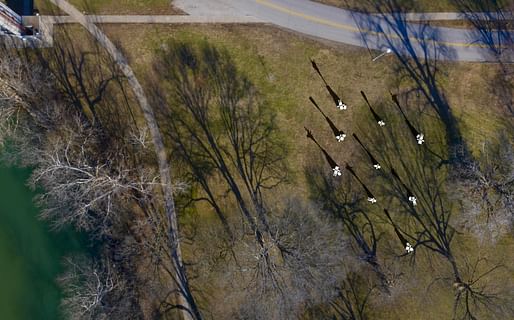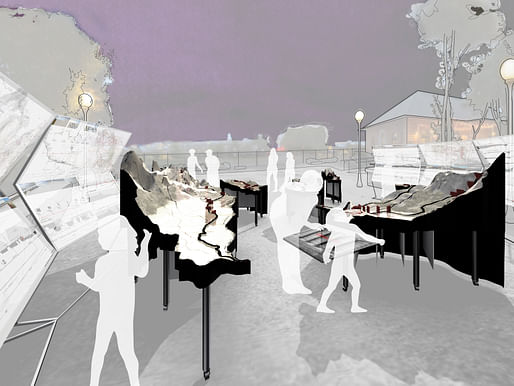

Exhibit Columbus' virtual presentations allowed the public to join in online and listen to thirteen presentations from the event's University Design Research Fellows, High School Design Team, and J. Irwin and Xenia S. Miller Prize winners.
Exhibit Columbus has shared project renders for eight site-specific installations developed by the University Design Research Fellows and High School Design Team for an exclusive preview.
For this year's iteration, seven fellowships were awarded to leading professors of architecture, landscape architecture, and design from seven universities. Each installation highlights the research of each individual. Fellows were selected for their "ability to tackle specific sets of issues germane to the future of the city and the Mississippi Watershed region, such as sustainability and material reuse, non-human habitat, watershed ecologies, emergent technologies, and migration."
Derek Hoeferlin — Washington University in St. Louis
Installation: Tracing Our Mississippi

Installation Description: Tracing Our Mississippi will be an interactive installation and public programming series at the site of the Columbus Pump House, on a terrace adjacent to the Flatrock River. By representing the Mississippi Watershed as a large-scale, abstracted model (composed as a set of moveable pieces), and complemented by a series of large-format drawings drawn at multiple scales, the installation emphasizes the relentless infrastructures controlling the Mississippi’s landscapes, communities, and resources. Hoeferlin’s project in Columbus and ongoing research presents the question: Is the Mississippi Watershed really a watershed anymore?
Joyce Hwang — University at Buffalo
Installation: To Middle Species, with Love
Installation Description: To Middle Species, with Love is designed to amplify habitat conditions for urban wildlife in Columbus and bring increased visibility to their presence among us, as co-inhabitants of the built environment. These animals—which we call “Middle Species” in contrast to “flagship” species—are common and embedded in our communities: bats, birds, reptiles. They are neighbors and residents who are active agents in our urban ecosystems and contribute significantly to the health of cities, yet often remain invisible in our imaginations of where we live.
Sited within the landscape of Mill Race Park, Hwang’s installation is conceived of as a series of “strata,” featuring bat and bird habitat conditions above, and environments for terrestrial and amphibious species below. To shift human perception to sense the less-visible world of urban animals, the project provides visitors ways to explore Middle Species sounds—particularly bat echolocation—by using ultrasonic detectors to regularly record bat calls, and make the recordings accessible to visitors—both in-person and through online platforms.
Jei Jeeyea Kim — Indiana University
Installation: LaWaSo Ground
Installation Details: LaWaSo Ground is a contemporary memorial and a community ground of (La)nd, (Wa)ter, and (So)il designed to help bridge some of the cultural dichotomies of our time through the lens of material culture. Sited on the lawn of First Christian Church, the installation draws from an acknowledgment of the silenced and suppressed voices of the past, and advocates for more diverse inclusion in the future. LaWaSo Ground combines stone elements that echo the topography of the limestone quarries found in the region with landscape mounds reminiscent of Indigenous earthworks along the Mississippi and Ohio River Valleys.
Ersela Kripa and Stephen Mueller — Texas Tech College of Architecture, El Paso
Installation: Spectral
Installation Description: Spectral addresses the legacy of aerial activity above the city and speculates on a future in which urban spaces are cognizant of their engagement with aerial imaging technologies. Recent advances in aerial imaging have rapidly expanded the ability for a host of actors to detect and respond to changes in cities, landscapes, and public spaces. Beyond the visible spectrum, these technologies record and analyze sub-perceptual shifts in heat signatures, radio waves, and radiation. Low-cost and widely accessible imaging devices have transformed the city into a multispectral environment, where previously invisible activities are newly detectable.
As an installation adjacent to the historic Crump Theater, Spectral is designed as both a public gathering place and a meditation on how and what is seen has changed from projected light (the movie theater) to increasingly pervasive aerial infrared imaging. The thermal activity of visitors to the site will be shielded from the view of multispectral cameras, making it a kind of “safe space” in the urban landscape.
Ang Li — Northeastern University
Installation: Window Dressing
Installation Details: Window Dressing is a façade installation along the Washington Street face of The Commons that invites the public to reflect on the cultural and architectural legacy of Late Modernism. Through a lightweight and ornamental cladding system of overlapping mylar shingles, the installation recalls the mirror-glass façade of the original 1973 building designed by César Pelli and Norma Merrick Sklarek of Gruen Associates, which was demolished in 2008. Li’s research into the conflicting material histories of mirrored glass—first developed by the aerospace industry then rapidly used within architecture throughout the 1970s—continues her interest into the afterlife of building materials. Her installation, in contrast to the smooth and hermetic surface of the curtain wall façade, will present layered reflections of the surrounding context and the shiny mylar shingles will react dynamically to changing atmospheres and events: wind and light, pedestrian traffic, and the civic rhythms of downtown Columbus.
Lola Shepherd and Mason White — University of Toronto & Waterloo University
Installation: THIS APPEARANCE IS ______
Installation Details: This Appearance Is ____ invites citizens into the space of appearance and disappearance. In the 1950s, Hannah Arendt viewed the public realm as a collaborative process of world-making; that which is seen and heard in common is continually reaffirmed as constituting a “space of appearance.” Today, however, our collective space of appearance is fragmented, as are individual visibilities and perceptions. How can we negotiate our visibilities today?
Located along Washington Street north of 6th Street, the installation is a study in the ability to retreat from and then rejoin the larger world—a test made all the more poignant after more than a year of pandemic restrictions. This Appearance Is ____, the title a homonym for “disappearances”, is a maze of curved walls made of lenticular plastic sheets which create a unique optical condition, effectively blurring the subject from view and allowing them to disappear almost completely within the installation. These surprising optical effects are designed to invite visitors to weave in and out of the structures.. By night, the panels will be illuminated, creating an ethereal ribbon of light creating shadowy and lit figures.
Natalie Yates — Ball State University
Installation: Calibrate
Installation Details: Calibrate is an apparatus for registering and perceiving multiple scales of intricate, accumulated environment data gathered from across Columbus and its environs. This installation in the courtyard of Franklin Square, home of the Heritage Fund of Bartholomew County, records the cultivated ecological layers of a city rich in making, creativity, and innovation over multiple, disparate timescales—from geologic time to real-time sensing data. The aggregation of thousands of years of glacial motion, together with the Ohio River watershed ecosystem has long nourished anthropogenic ingenuity for industry, agriculture, and technology.
Influencing and promoting young designers' work, Exhibit Columbus emphasizes that the city's architectural legacy and community impact began with investments made in schools. Inspired by J. Irwin Miller and his mission to bridge architecture and the youth, this year, Exhibit Columbus invited high school students to participate as a means to "educate the next generation of the Columbus community."
Exhibit Columbus High School Student Design Team — Students on the team attend Columbus North High School, Columbus East High School, and Hauser High School
Installation: Tunnel Vision
Installation Details: The foundation of middle cities is based on rivers. These waterways shape how cities are formed and how they develop into the future. Tunnel Vision looks at how Columbus was formed as a middle city and how it can develop into a larger city. Just as rivers have a linear path, our geodesic tunnel is a linear experience that transports you through history. Visitors enter the structure at the base of the “river”, represented in colored panels that tell a story of how Columbus revolutionized modern architecture. As visitors flow through the tunnel, informational videos, viewable by QR codes, teach guests about Columbus’ architecture. Columbus is expanding, and we created a video predicting possible changes to the city that will be made over time.
*Stay tuned for Part 2 of Archinect's installation preview, where we dive into the projects of the 2021 J. Irwin and Xenia S. Miller Prize winners.
No Comments
Block this user
Are you sure you want to block this user and hide all related comments throughout the site?
Archinect
This is your first comment on Archinect. Your comment will be visible once approved.